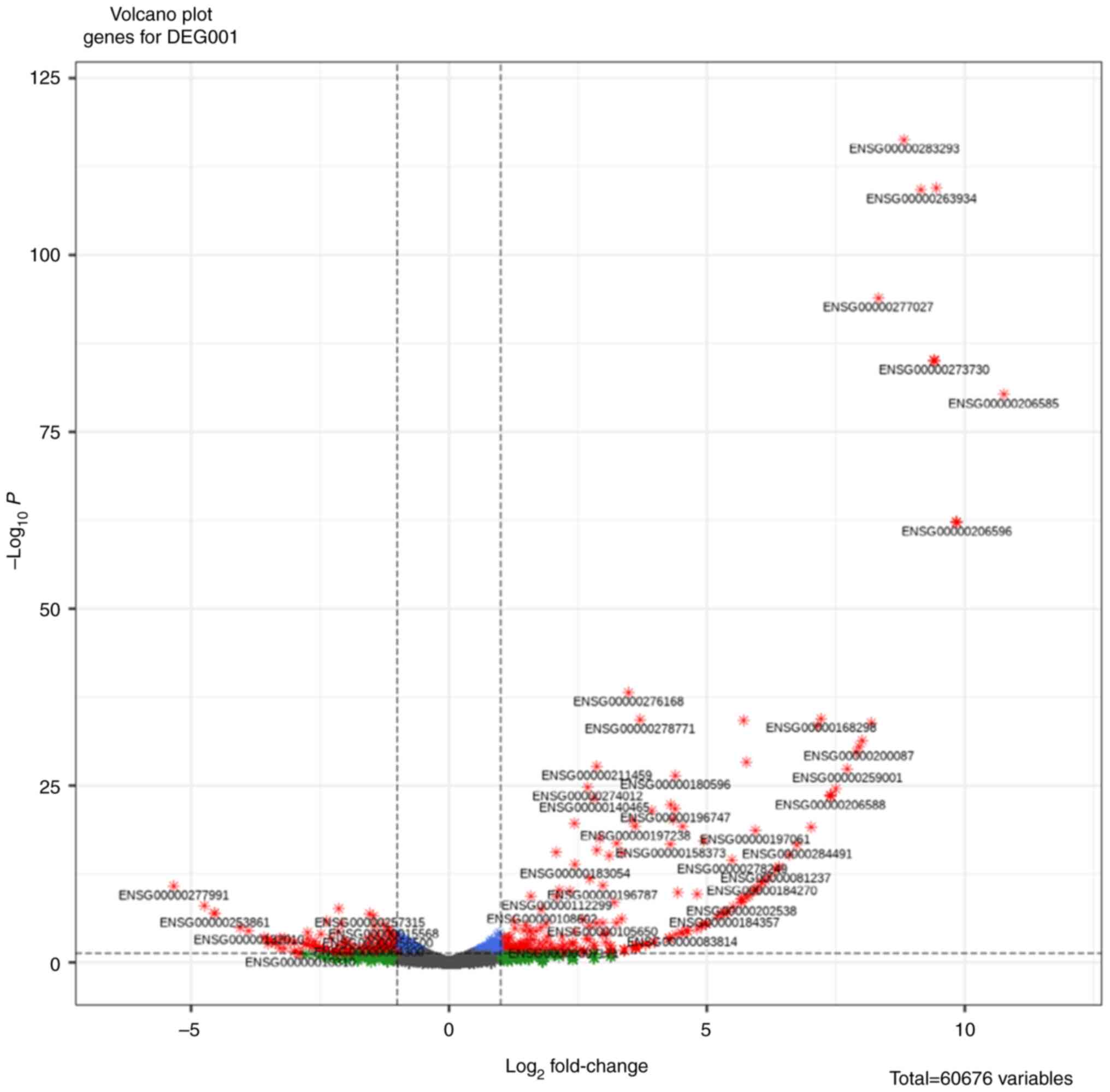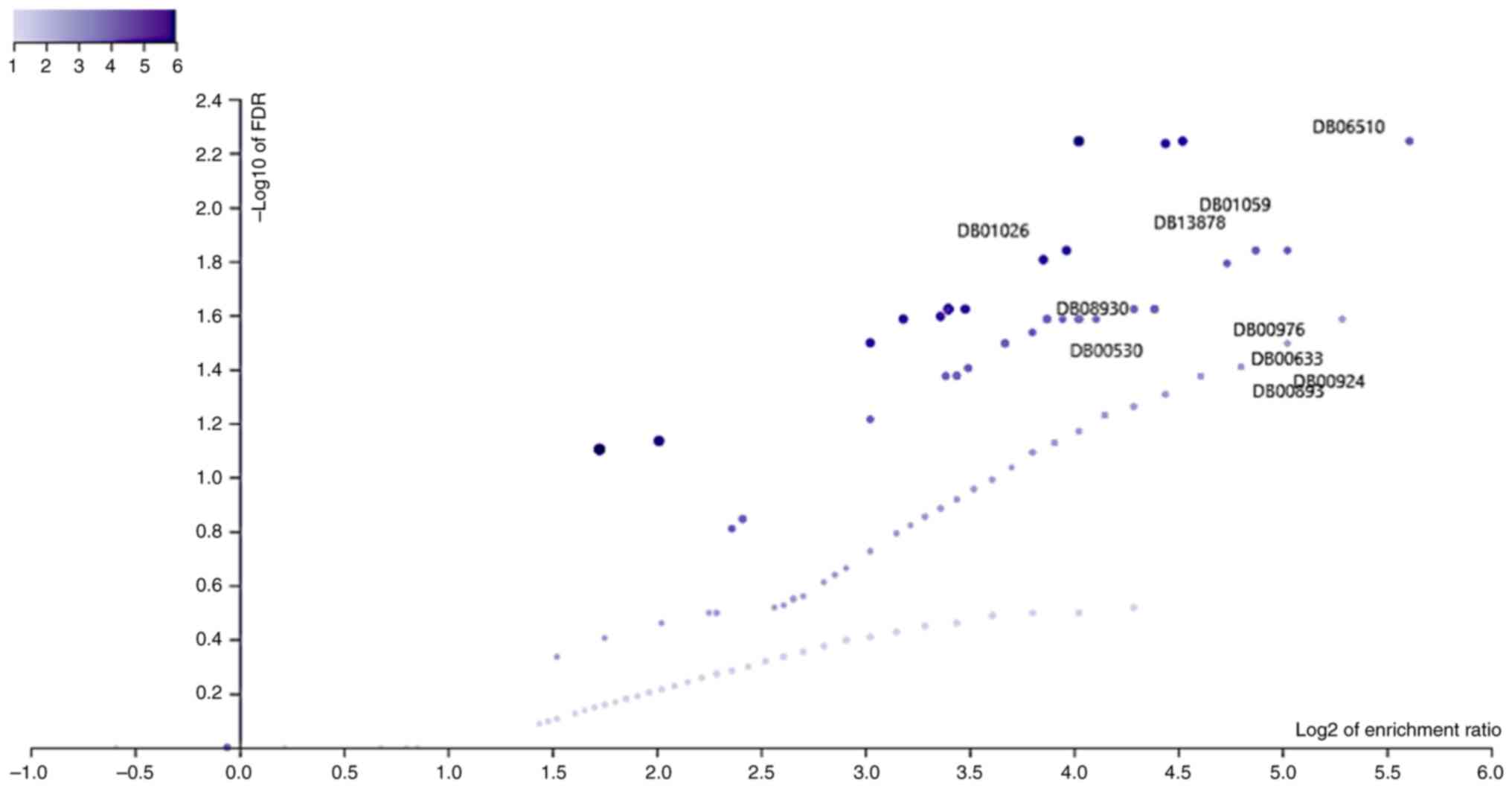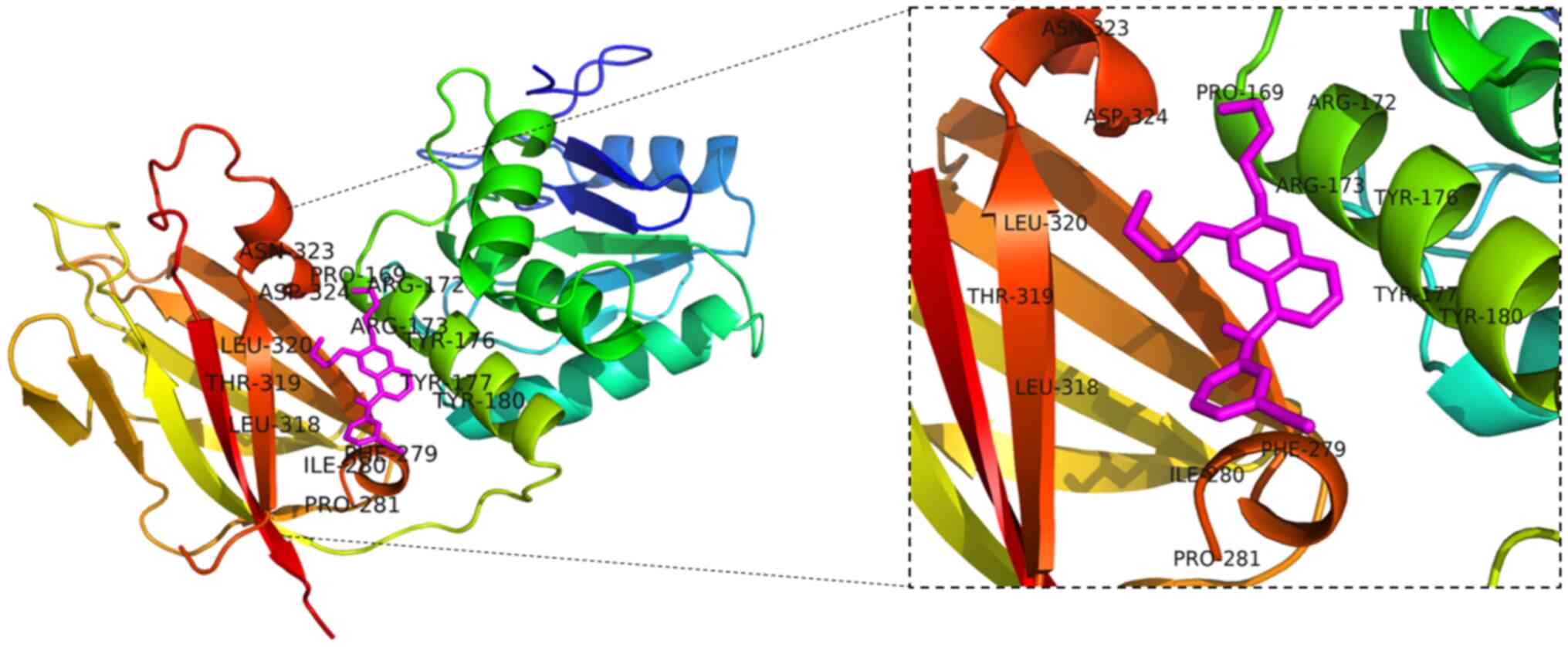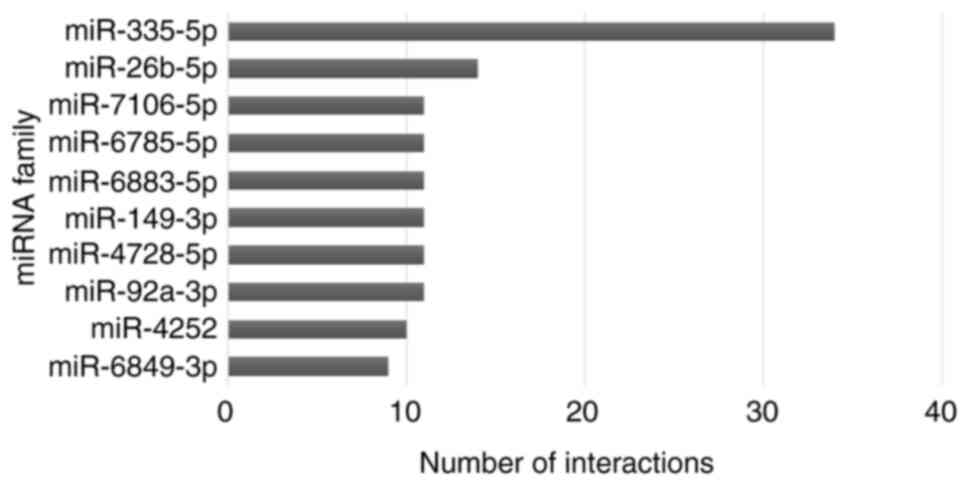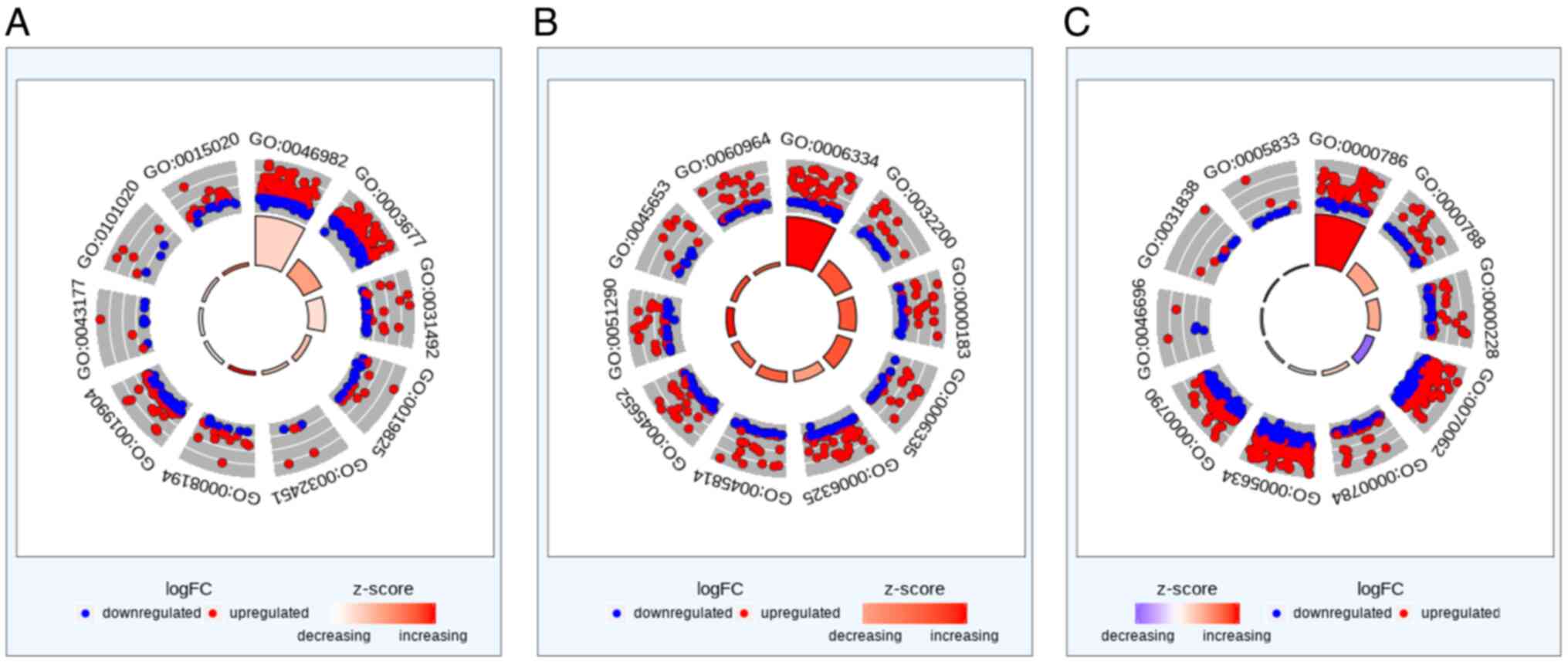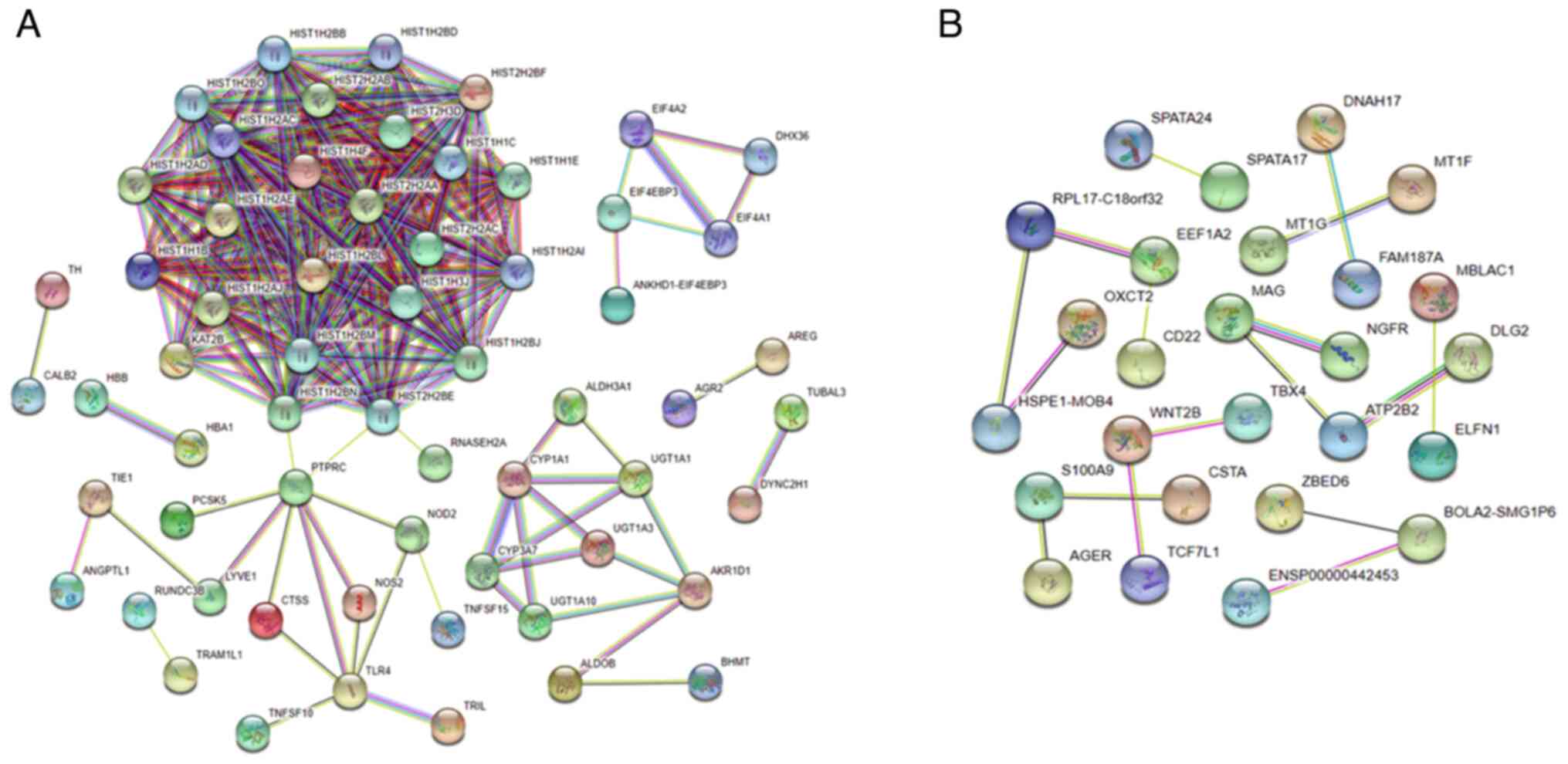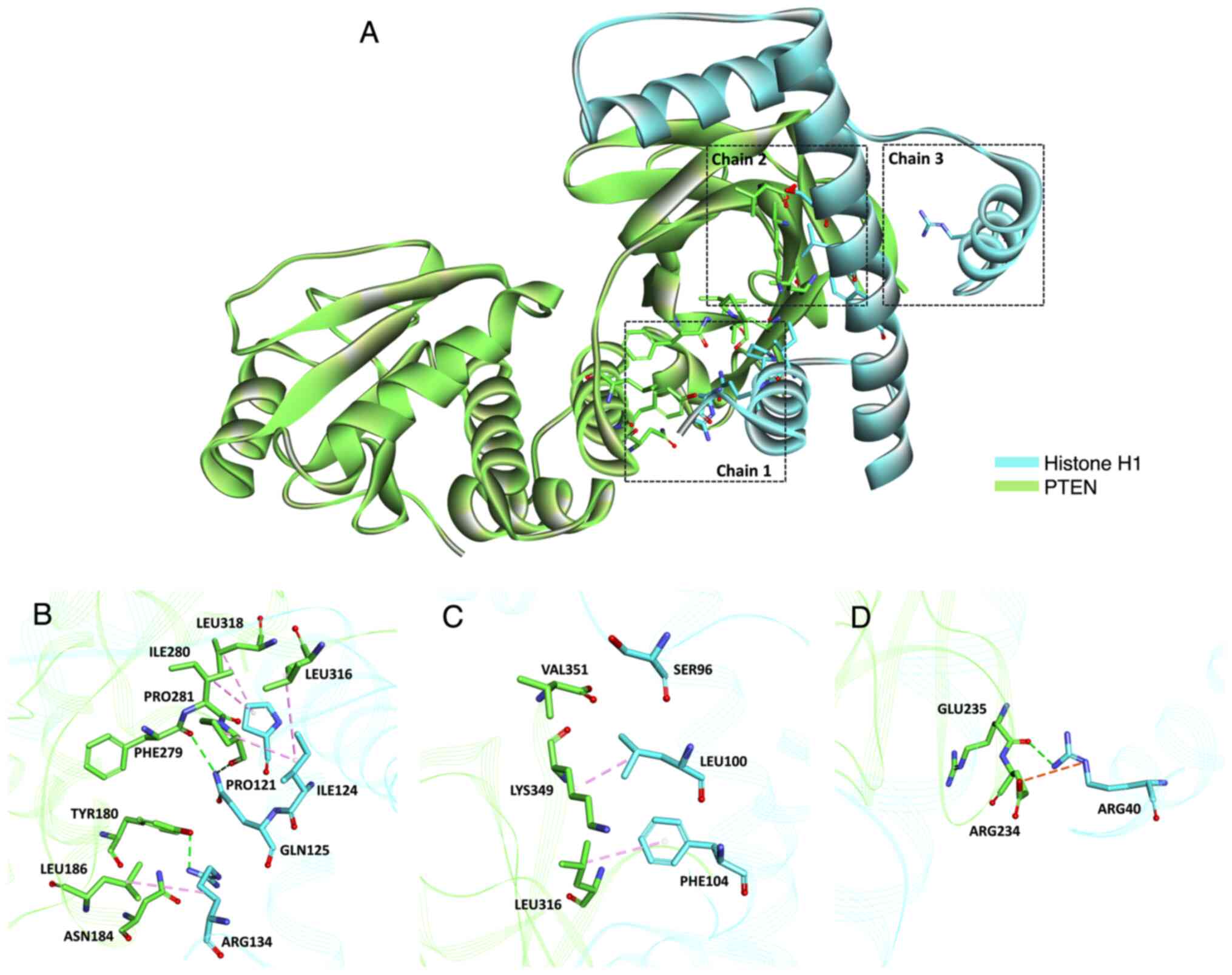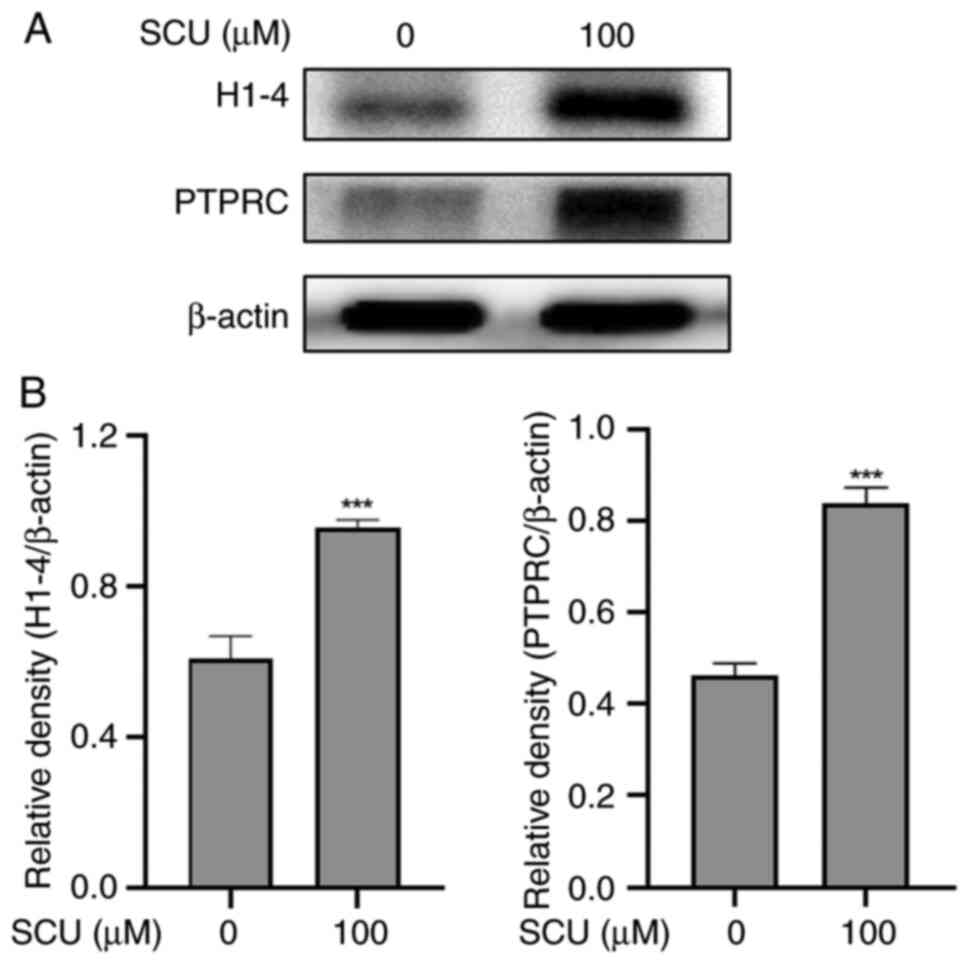Comprehensive transcriptomic profiling of liver cancer identifies that histone and PTEN are major regulators of SCU‑induced antitumor activity
- This article is part of the special Issue: Molecular target and action mechanism of anti-cancer agents
- Authors:
- Published online on: January 11, 2024 https://doi.org/10.3892/ol.2024.14227
- Article Number: 94
-
Copyright: © Ha et al. This is an open access article distributed under the terms of Creative Commons Attribution License.
Abstract
Introduction
Liver cancer is still a primary global health concern, and its incidence rate is rising worldwide (1). According to the GLOBOCAN report from 2018, more than 1 million people will be diagnosed with liver cancer by 2025. The most prevalent form of liver cancer, known as human hepatocellular carcinoma (HCC), makes up around 90% of all cases that are detected (2). Because of the difficulty in getting an early diagnosis and the limited number of therapy options, the majority of patients with advanced-stage HCC have poor treatment outcomes (3). In recent years, novel treatment options for HCC have developed. Especially, many studies have investigated the synergistic effects and enhanced antitumor activity of combining locoregional and systemic therapies, based on strong biological rationale (4–7). Therefore, the creation of novel biomarkers and the creation of gene expression profiles are essential for improving early detection and precise prognosis as well as for offering a chance to better match the most efficient medications with the molecular characteristics of each patient (8).
A biomarker is defined as any substance, structure, or function that can be detected in the body, which influences or predicts the incidence of outcome or disease (9). This can be used to track early cancer detection, assess the prognosis, or gauge the effectiveness of therapy. The ideal biomarker is readily accessible, consistently measurable, cost-effective, and extremely accurate (10). In cancer, several recent advances have led to the diffusion of potential biomarkers, from genetic materials (e.g., DNA, epigenetic changes, cell-free DNA, RNA, mRNA), serum proteins, and circulating metabolites (11,12). Although there are several identified biomarkers are available like glypican 3 (GPC3), Golgi protein-73 (GP73), descarboxypro-thrombin (DCP), glutamic pyruvic transaminase (GPT), gamma-glutamyl carboxylase (GGCX), and osteopontin (OPN) as complementary biomarkers for liver cancer diagnosis (13–16), the early and specific diagnosis of liver cancer remains challenging. Thus, it is crucial to identify more biomarkers concerning liver cancer for better treatment and prognosis.
The molecular mechanism of liver cancer is now better-understood thanks to the quick development of molecular biology tools like high throughput sequencing, microarrays, and different omics approaches. Epigenetics in particular has a well-established function and is just as important as genetics (17). Recent advances in the knowledge of the molecular biomarkers involved in the onset and progression of liver cancer as well as in the comprehensive mapping of the disease's key mechanisms have been made possible by the use of integrated multi-omics studies (18–20).
Transcriptomic analysis is a method that uses bioinformatics tools to examine changed target genes and comprehend the mechanism of action of a medicine after screening with an in vitro model (21). To better understand factors like particular pathways altered by a candidate meditation, differential gene expression under drug-treated disease conditions can be helpful (22). Additionally, gene expression information gleaned from transcriptome data can result in the discovery of new key genes connected to a pathway (23). Target identification with the use of natural products can accelerate patient-specific treatment methods.
New therapeutic alternatives are required for liver cancer patients. Using natural chemicals or nanotechnology could offer improved therapy with less toxicity and fewer side effects for patients, potentially leading to better prognoses (24). Scutellarein (SCU), a flavone present in the perennial herb Scutellaria baicalensis, is the aglycone of scutellarin with a free hydroxyl in 7 positions and has a higher bioavailability than scutellarin (25). Numerous research has shown that SCU may reduce the viability of human lung cancer cells and fibrosarcoma cells (26,27). It also depicted an anti-tumor effect in human colon cancer (28,29). In addition, our previous study showed that SCU inhibited cell proliferation and metastasis by upregulating PTEN in human hepatocellular carcinoma (30). First discovered as a tumor suppressor, PTEN (phosphatase and tensin homolog deleted on chromosome 10) is a highly targeted protein in a number of human illnesses (31,32). PTEN activity and expression appear to be regulated by a variety of intricate processes, which is consistent with these perspectives. Among these mechanisms, epigenetic silencing by hypermethylation of its promoter (33) or histone deacetylase activity (34) strongly affects PTEN expression. Even so, the mechanism of PTEN regulation remains elusive.
Histone modifications have long been assumed that they have a practical impact on the control of transcription (35). Linker histone H1 (Histone H1) is a chromatin structural component that aids in the structuring and stability of higher-order condensed chromatin structures (36). The higher expression of histone H1 shows that the SCU induces anti-tumor activity through histone H1 (37). PTEN physically binds with histone H1 to maintain a condensed chromatin structure, which is reflected by histone H1 chromatin occupancy and hypoacetylation of histone H4, resulting in suppression of overall gene activity (38). Knockdown of H1 in HCC1954 cells promoted an increase in renewable cancer stem cells (37).
Overall, the main objective of this study was to use a transcriptomic approach to find potential targets of SCU for treating liver cancer. Additionally, the study aimed to gain a deeper understanding of the connection between crucial targets that regulate PTEN, which has previously been identified as an anti-tumor agent for SCU (30).
Materials and methods
Cell culture
Human liver cancer HepG2 cell line was obtained from the Korean Cell Line Bank (Seoul, Korea). HepG2 cells were cultured in Dulbecco's modified Eagle's medium (DMEM) (Gibco; Thermo Fisher Scientific, Inc.) containing 10% fetal bovine serum (FBS) (Gibco; Thermo Fisher Scientific, Inc.), and 100 U/ml penicillin/100 µg/ml streptomycin (P/S) (Gibco; Thermo Fisher Scientific, Inc.) at 37°C of 5% CO2. Scutellarein (SCU) was purchased from Chengdu Biopurify Phytochemicals Ltd. (Chengdu, Sichuan, China).
Isolation of RNA for sequencing
HepG2 cells were seeded into 6-well plates at 1.5×105 cells per well and treated with 100 µM of SCU for 48 h at 37°C of 5% CO2. After incubation, total RNAs were extracted using TRIzol (Ambion, Thermo Scientific, Rockford, IL, USA). The concentration of RNA was determined using a spectrophotometer (BioTek, Winooski, VT, USA). Isolated total RNA was then subjected to sequencing to obtain expression data.
Library preparation and sequencing
The mRNA sequencing was prepared by Theragenbio (Seongnam-si, Gyeonggi-do) using the following protocol (Table I). The libraries were prepared for 151bp paired-end sequencing using TruSeq stranded mRNA Sample Preparation Kit (Illumina, CA, USA). Utilizing oligo (dT) magnetic beads, mRNA molecules were specifically isolated and fragmented from 1 µg of total RNA. The fragmented mRNAs were synthesized as single-stranded cDNAs through random hexamer priming. Double-stranded cDNA was created by using this as a template for second-strand synthesis. After the sequential process of end repair, A-tailing, and adapter ligation, cDNA libraries were amplified with PCR (Polymerase Chain Reaction). The quality of these cDNA libraries was evaluated with the Agilent 2100 BioAnalyzer (Agilent, CA, USA). According to the manufacturer's library quantification methodology, they were measured using the KAPA library quantification kit (Kapa Biosystems, MA, USA). Following cluster amplification of denatured templates, sequencing was progressed as paired-end (2×151 bp) using Illumina NovaSeq6000 (Illumina, CA, USA).
Transcriptome data analysis
FilteringThe adapter sequences and ends of the reads less than Phred quality score 20 were trimmed and simultaneously the reads shorter than 50 bp were removed by using cutadapt v.2.8 (39).
Sequence alignment
Using the aligner STAR v.2.7.1a (40) and the ‘quantMode TranscriptomeSAM’ option for estimating transcriptome expression level, filtered reads were mapped to the reference genome associated with the species using ENCODE standard parameters (see to ‘Alignment’ of ‘Help’ section of the HTML report).
Gene expression estimation
By using the ‘strandedness’ option in RSEM v.1.3.1 (41) and taking into account the reads' direction in relation to the library technique, gene expression was estimated. The ‘estimate-rspd’ option was used to increase measurement accuracy. The default settings were used for all other options. FPKM (Fragments Per Kilobase Million) and TPM (Transcripts Per Kilobase Million) values were generated to standardize sequencing depth among samples.
Differentially expressed genes (DEG) analysis
The R package TCC v.1.26.0 was used to identify DEG based on the projected read counts from the preceding stage (42). TCC program compares tag count data using effective normalizing techniques. With the use of the iterative DESeq2 (43)/edgeR (44) approach, normalization factors were computed. Using the p.adjust function of the R package with the default parameter settings, the q-value was determined based on the P-value. Based on the q-value criterion of less than 0.05 for correcting mistakes brought on by multiple testing, the DEG were found.
Drug and disease association analyses
To predict drug and disease associations for candidate genes, our analysis was carried out in a functional database that was suggested (i.e., Drug Bank) by WEB-based GEne SeT AnaLysis (WebGestalt). Drug Bank and drug were chosen as the functional database and enrichment category, respectively, to predict the most important drugs for our target genes. The gene count was set at ≥ 5, and a P-value with a false discovery rate (FDR) adjusted of less than 0.05 was considered statistically significant. The WebGestalt derives significance results by clustering sets of genes using the Jaccard index as a criterion of similarity, prioritizing sets with significant P-value, and automatically identifying a ‘model’ or representative for each cluster (45).
miRNA-target enrichment analysis
Mienturnet (MicroRNA ENrichment TURned NETwork) is used to predict the miRNA target related to differentially regulated genes. 463 DEG was taken for prediction (both up and down-regulated). Out of 665 entries, we chose the top 10 entries based on the number of interactions.
Gene ontology (GO) analysis
GO database provides a set of hierarchical controlled vocabulary classified into 3 categories: Biological Process (BP), Cellular Component (CC), and Molecular Function (MF). For functional characterization of the DEG, a GO-based trend test was carried out using the R package called GOseq (46) through the Wallenius non-central hypergeometric distribution. Selected genes of P-value <0.05 following the test were regarded as statistically significant.
Molecular docking analysis
Molecular docking of Erlotinib and PTEN were performed using PyMol (The PyMOL Molecular Graphics System, Version 1.2r3pre, Schrödinger, LLC.) and USCF (47) chimera with the default parameters. Molecular docking of histone H1 and PTEN were performed using HDOCK server (http://hdock.phys.hust.edu.cn/) with the default parameters. Analysis for molecular interaction between histone H1 and PTEN was conducted through Discovery Studio 2018 (BIOVIA, San Diego, CA, USA).
STRING network analysis and pathway enrichment on the identifiable targets
The protein-protein interaction for up-regulated and down-regulated genes was performed using an online tool, Search Tool for the Retrieval of Interacting Genes/Proteins (STRING) (Accessed on 24, Jun 2021). Up-regulated gene interaction showed about 61 nodes, whereas the expected number of nodes was 57 (P-value; 1×1016). Down-regulated gene interaction showed about 26 nodes, whereas the expected number of nodes was 2 (P-value; 7.47×1011). Thus, the interaction was more significant than expected. In up-regulated genes, the significant pathways enriched were chosen based on KEGG, Wiki, and Reactome pathway analyses.
Western blot analysis
HepG2 cells were treated with indicated concentrations of SCU (0, 25, and 100) µM and lysed using radioimmunoprecipitation assay (RIPA) buffer (iNtRON Biotechnology, Seoul, Korea) containing phosphatase and protease inhibitor cocktail (Thermo Scientific, Rockford, IL, USA). Protein quantification were determined using a Pierce™ BCA assay (Thermo Fisher Scientific, Rockford, IL, USA). An equal quantity of protein (10 µg) from each sample was electrophoresed on (8–15)% SDS-polyacrylamide gels and transferred to a polyvinylidene difluoride (PVDF) membrane (ATTO Co., Ltd., Tokyo, Japan). Membranes were blocked with 5% (bovine serum albumin (BSA) in Tris-buffered saline containing 1% Tween 20 (TBS-T, pH 7.4) at room temperature for 1 h, and incubated overnight at 4°C with primary antibodies. The membranes were washed with TBS-T buffer for every 15 min in five times at room temperature, further they were incubated with 1:5,000 dilution of HRP-conjugated secondary antibody for 2–3 h at room temperature. The obtained proteins were detected by an electrochemiluminescence (ECL) detection system (Bio-Rad Laboratory, Hercules, CA, USA), and analyzed using the Image Lab 4.1 (Bio-Rad) program. The densitometry readings of the protein bands were normalized by comparison with the expression of β-actin as control, using the ImageJ software program (U.S. National Institutes of Health, Bethesda, MD, USA). Antibodies of histone H1-4 (Cat. no. 41328S), PTPRC (Cat. no. 72787S), and β-actin (Cat. no. 4970S) were purchased from Cell Signaling Technology (Danvers, MA, USA). Horseradish peroxidase (HRP)-conjugated secondary antibodies to anti-rabbit (cat. no. A120-101P) and anti-mouse (cat. no. A90-116P) were obtained from Bethyl Laboratories, Inc (Montgomery, USA).
Statistical analysis
Western blot experimental data were analyzed using GraphPad Prism version 8.0.2 (GraphPad Software). The findings were presented as the means ± standard deviation (SD) of triplicate samples. The unpaired Student's t-test was used to analyze the results, and a P-value of <0.05 was considered statistically significant.
Results
Identification of DEG
In our previous study on scutellarein (SCU) treatment in human liver cancer HepG2 cells, we revealed that SCU could inhibit cell proliferation and metastasis through PTEN activation in HepG2 cells (30). Herein, SCU-treated group were compared against the SCU-untreated group which unraveled about total of 463 DEG (|log2 FC|>1.0 and P-value <0.05), including 288 up-regulated and 175 down-regulated DEG (Table II). The DEG was represented as a volcano plot using an R-Bioconductor, which consists of a total of 60,676 variables (Fig. 1).
Therapeutic drug association analysis and molecular docking with PTEN
To identify the relationship between DEG and already available drugs we performed a drug-disease association analysis. After drug and disease association analyses (Fig. 2, Table III), we took the top 10 drugs which were significantly associated with DEG (FDR <0.05, gene count was set at ≥5). Among these drugs, the most effective cancer-specific drug is Erlotinib and which is a PTEN regulatory target drug (48). Furthermore, Erlotinib is associated with liver cancer, and it is used for the clinical treatment of liver cancer patients as a sole treatment or combination treatment with Sorafenib (49). To confirm the interaction of Erlotinib with PTEN, we performed drug and protein molecular docking (Fig. 3). UCSF Chimera software was used to validate the ligand-protein structures of these molecules. According to molecular docking studies, as shown in the image with the co-crystallized ligand, the two ligands occupied the active site. It was also discovered that many residues assisted in fitting the ligands into the binding pocket. The interacting amino acid residues involved in the bound complex of Erlotinib with PTEN were found to be PRO169, AGR172, ARG173, TYR176, TYR177, TYR180, PHE279, ILE280, PRO281, LEU318, THR319, LEU320, ASP324, and ASN323 (Table IV). The molecular dock scores suggest that the compound demonstrated PyMOL final intramolecular energy of −7.45 kcal/mol. In summary, SCU is associated with the drug Erlotinib, which is used as a clinical drug to treat PTEN-related diseases such as liver cancer. The development and use of peptides or inhibitors that target PTEN-related kinases, transcription factors, and cellular proteins could have a significant therapeutic benefit in the treatment of PTEN-related diseases (48). Therefore, we strongly suggest a strong relationship between DEG and PTEN.
miRNA-DEG target prediction
Target identification of miRNA concerning DEG was performed with the use of an online tool Mienturnet (MicroRNA ENrichment TURned NETwork). Mienturnet predicts the target miRNA based on statistical analysis, network-based visualization, and analysis. Around 665 putative target miRNA were predicted concerning 463 DEG. The top 10 miRNA targets were selected based on the number of interactions and plotted in a graph. miR-335-5p and miR-26b-5p showed a high number of target interactions which is about 34 and 14 (Fig. 4).
Functional and enrichment analysis
Functional enrichment analysis is a method for locating gene or protein classes that are disproportionately represented in a big collection of genes or proteins that may be associated with anti-tumor properties. When these hub genes were subjected to enrichment analysis to identify significant gene ontology (GO) terms, a list of up-regulated and down-regulated genes involved in nucleosomes, cellular content, and molecular function were shown in Fig. 5. The highly expressed function in each category is listed in Table V. Additionally, Linker histone H1 (Histone H1) was involved in all obtained enriched functional analyses.
Table V.List of enriched GO in terms of (A) molecular function, (B) biological process and (C) cellular component. |
PPI network interaction and pathway enrichment analysis
Fig. 6A and B show the protein-protein interaction (PPI) network of up-regulated and down-regulated genes. The histone has a higher degree of the up-regulated PPI network, including 61 nodes and 293 edges. In contrast, the down-regulated PPI network, including 26 nodes and 17 edges, shows no significant relations. The figure summarizes the network of anticipated connections for a specific protein group. The edges represent the anticipated functional connections based on seven types of evidence: fusion evidence, neighborhood evidence, concurrence evidence, experimental evidence, text mining evidence, database evidence, and co-expression evidence. In addition, the pathway enrichment analysis of the potential targets were identified using different database (Table VI). Table VI lists the results of the screening. The KEGG database were found to be necroptosis, drug metabolism, pentose and glucuronate interconversions, porphyrin and chlorophyll metabolism, and phagosome pathway. Wiki database was found to be histone modifications, codeine and morphine metabolism, tamoxifen metabolism, and translation factors pathway. Reactome database shown to be HDACs deacetylate histones, DNA methylation, PRC2 methylates histones and DNA, Transcriptional regulation by small RNAs, deubiquitination, apoptosis induced DNA fragmentation, and caspase activation via death receptors in the presence of ligand pathway.
Crucial target molecular docking
The interactions among these three nodes and their first adjacent nodes were used to construct the sub-network (Fig. 7A-D). In our previous study, we have shown that SCU anti-tumor activity is regulated by PTEN (30), and transcriptomics analysis showed the role of histone is evident. To unravel the interaction between PTEN and histone H1, we performed molecular docking.
Validation of target protein expression using western blot assay
After examining the STRING analysis, the two crucial targets were validated by western analysis on SCU-treated HepG2 cells. These selected target proteins histone H1-4 (H1-4) and protein tyrosine phosphatase receptor type C (PTPRC) upon treatment with 100 µΜ of SCU in HepG2 cells. Fig. 8 shows that SCU up-regulated the expression of histone H1-4 (H1-4) and PTPRC respectively. These results further certify the role of SCU in regulating the expression of crucial targets in HepG2 cells.
Discussion
The development of RNA sequencing (RNA-seq) technology has increased the potential of RNA-based biomolecules for diagnostic, prognostic, and therapeutic applications in a variety of disorders, including cancer and many infectious diseases. (50). The complexity of cancer is made up of many different transcriptional programs that are widely linked with tumor cell populations. These transcriptional programs are also thought to be the main causes of therapy resistance, recurrence, and poor prognosis (51). Improved patient-specific treatment options were made possible by the use of RNA-seq analysis to identify gene expression and transcriptional changes in cancer patients (52).
Hereby, we analyzed the anti-cancer regulatory genes including anti-tumor, proliferation, and metastasis of scutellarein (SCU) in HepG2 cells with the use of RNA-seq. We observed 60,676 variables of genes demonstrating differential expression compared with the SCU-untreated group and SCU-treated group. The analysis revealed a total of 463 significant differentially expressed genes (DEG), 288 up-regulated and 175 down-regulated.
Based on the DEG data, drug and disease association analyses were performed. The first 10 enriched drugs were sorted, and among those on the top list, it was confirmed through previous studies that Erlotinib was related to PTEN (48). The target of Erlotinib is the epidermal growth factor receptor (EGFR), and it has been found that there is a ‘PTEN loss contributes to Erloninib resistance’ effect. The reference provider name used for the current patient is OSI Pharmaceuticals US6900221 (53). In our previous study, we revealed that SCU is a potent PTEN activator (30). Therefore, these findings suggest that SCU may have a similar function to Erlotinib, thus consistent with our previous study.
The obtained DEG participates in various regulatory networks. We conducted a gene ontology (GO) analysis to determine their molecular function, biological process, and cellular component. The results showed that genes related to histone and linker histone were ranked high in all three terms. Protein heterodimerization activity is highly enriched in the molecular function that consists of 42 genes of DEG. Protein heterodimerization is a highly conserved process and any deregulation in this process might lead to several inflammatory diseases. Histones function within the nucleus to package and organize DNA (54). The great degree of conservation of histones H3 and H4 throughout eukaryotic evolution suggests that they are crucial for structural and functional functions (55,56). These histones exist in chromatin in a precise stoichiometry and wrap DNA to provide a crucial architectural framework for the nucleosome (57). Histone H4 interacts with H3 via their C-terminal histone fold domains to form heterodimers (55). Interestingly, nucleosome assembly is also highly enriched in a biological process that consists of 28 genes of DEG.
Furthermore, the nucleosome assembly's synonym is histone chaperone. When histones are deposited during nucleosome formation or when histones are disassembled, histone chaperones are involved (58). The nucleosome is highly enriched in the cellular component that consists of 98 genes of DEG. miRNA prediction also showed the highly enriched miRNA-335-5p is related to histone (59). In addition, as a tumor suppressor in human hepatocellular carcinoma (HCC), miRNA-335-5p inhibited the growth, proliferation, and invasion of liver cancer cells (60). miRNA-26B-5P is associated with PTEN (61). Thus, it regulates the proliferation, angiogenesis, and apoptosis in liver cancer (62).
In summary, all the results obtained from our study indicate that they are associated with histone-related functions. Our previous study showed that SCU regulates the PTEN-PI3K pathway. Interestingly, RNA-seq analysis revealed a differential regulation of genes related to histones. This discovery intrigued us to investigate the relationship between PTEN and histones. Therefore, we hypothesized that SCU regulates cell proliferation by sequentially modulating the activity of histones and PTEN. Protein-protein interaction (PPI) analysis using Search Tool for the Retrieval of Interacting Genes/Proteins (STRING) confirmed that the histone-related groups were highly interconnected. Among the histone group, linker histone H1-4 (H1-4) which showed the highest fold change value was taken to analyze the different associations with PTEN. Many studies have shown that PTEN forms a complex with histone H1 to promote a condensed chromatin structure, the presence of histone H1 in chromatin, and hypoacetylation of histone H4 leads to suppression of overall gene activity (38,63). In addition, the molecular interaction of the histone H1 showed active binding sites in all three chains with PTEN in docking analysis. GO analysis of DEG showed many enriched genes associated with the nucleosomes, like histones, emphasizing the PTEN-Histone relation, which falls in line with our hypothesis. In a recent study, Chen et al. showed that interaction between PTEN and histone H1 decreased H4K16 acetylation (38). Thus, PTEN is responsible for maintaining genomic integrity and preventing tumor growth. Therefore, histone H1-4 (H1-4) has a crucial role in SCU-induced anti-tumor activity. Accordingly, the closely linked protein tyrosine phosphatase receptor type C (PTPRC) proteins, including histone H1-4 (H1-4), were selected as important targets. PTPRC correlates with colorectal cancer disease stage and outcome, according to research (64). To support the prior research, we performed protein expression analysis for specific genes. The protein expression level of these two crucial targets matched our transcriptomic results.
Taken together, the analysis results of DEG and GO data provide insight into anti-cancer treatment in SCU-treated HepG2 cells. In this present study, we found that SCU induces upregulation of histone H1, histone H1 forms a complex with PTEN and regulates the crucial target gene, PTPRC. Consistent with our previous study, the current results support that SCU inhibits the proliferation of HepG2 cells by its molecular action with the PTEN-PI3K pathway. Targeting the pathway can be an attractive strategy for cancer treatment, and SCU can be used as a target drug to inhibit PI3K/Akt signaling, a downstream pathway, by activating PTEN. It has been demonstrated that targeted therapy can be attributed to aberrant expression of signal transduction pathways such PTEN/PI3K/Akt (65). This study focuses in-depth on PTEN/PI3K/Akt-related gene changes as the cause of this pathway's dysregulated expression. The expression of this pathway can be controlled to enhance cancer treatment. Therefore, it suggests that SCU, a natural product known to have few side effects, can be considered as a potential treatment for liver cancer.
As a result of this study, further preclinical and clinical trials are needed to implement a treatment strategy, but it can be used to provide basic data for the development of new drugs derived from natural products and for mechanism research.
Acknowledgements
Not applicable.
Funding
This study was supported by the National Research Foundation of Korea funded by the Ministry of Science and ICT (grant nos. 2022R1A6A3A01086899 and RS-2023-0024337661382).
Availability of data and materials
The datasets used and analyzed during the current study are available from the GEO database (accession no. GSE232800; http://www.ncbi.nlm.nih.gov/geo/query/acc.cgi?&acc=GSE232800). The other datasets used and/or analyzed during the current study are available from the corresponding author on reasonable request.
Author's contributions
SEH conceptualized the study. AP designed the methodology. SEH and AP performed the analysis of data, and wrote and prepared the original draft. SEH and AP confirmed the authenticity of all the raw data. SEH wrote, reviewed, and edited the manuscript. HHK and PBB performed the interpretation of data and revised the final manuscript. MYP and AA performed some experiments and validation of data. JDH and WSL contributed to the study conception and design. GSK conceptualized and supervised the study. All authors read and approved the final version of the manuscript.
Ethics approval and consent to participate
Not applicable.
Patient consent for publication
Not applicable.
Competing interests
The authors declare that they have no competing interests.
References
|
Llovet JM, Zucman-Rossi J, Pikarsky E, Sangro B, Schwartz M, Sherman M and Gores G: Hepatocellular carcinoma. Nat Rev Dis Primers. 2:160182016. View Article : Google Scholar : PubMed/NCBI | |
|
Di Bisceglie AM, Rustgi VK, Hoofnagle JH, Dusheiko GM and Lotze MT: NIH conference. Hepatocellular carcinoma. Ann Intern Med. 108:390–401. 1988. View Article : Google Scholar : PubMed/NCBI | |
|
Villanueva A and Llovet JM: Targeted therapies for hepatocellular carcinoma. Gastroenterology. 140:1410–1426. 2011. View Article : Google Scholar : PubMed/NCBI | |
|
Rizzo A, Ricci AD and Brandi G: Systemic adjuvant treatment in hepatocellular carcinoma: Tempted to do something rather than nothing. Future Oncol. 16:2587–2589. 2020. View Article : Google Scholar : PubMed/NCBI | |
|
Santoni M, Rizzo A, Mollica V, Matrana MR, Rosellini M, Faloppi L, Marchetti A, Battelli N and Massari F: The impact of gender on The efficacy of immune checkpoint inhibitors in cancer patients: The MOUSEION-01 study. Crit Rev Oncol Hematol. 170:1035962022. View Article : Google Scholar : PubMed/NCBI | |
|
Rizzo A, Ricci AD and Brandi G: Trans-arterial chemoembolization plus systemic treatments for hepatocellular carcinoma: An update. J Pers Med. 12:17882022. View Article : Google Scholar : PubMed/NCBI | |
|
Rizzo A, Ricci AD and Brandi G: Atezolizumab in advanced hepatocellular carcinoma: Good things come to those who wait. Immunotherapy. 13:637–644. 2021. View Article : Google Scholar : PubMed/NCBI | |
|
Bazzichetto C, Conciatori F, Pallocca M, Falcone I, Fanciulli M, Cognetti F, Milella M and Ciuffreda L: PTEN as a Prognostic/Predictive biomarker in cancer: An unfulfilled promise? Cancers (Basel). 11:4352019. View Article : Google Scholar : PubMed/NCBI | |
|
Sengupta S and Parikh ND: Biomarker development for hepatocellular carcinoma early detection: Current and future perspectives. Hepat Oncol. 4:111–122. 2017. View Article : Google Scholar : PubMed/NCBI | |
|
Ptolemy AS and Rifai N: What is a biomarker? Research investments and lack of clinical integration necessitate a review of biomarker terminology and validation schema. Scand J Clin Lab Invest. 242:6–14. 2010. View Article : Google Scholar : PubMed/NCBI | |
|
Tovar V, Cornella H, Moeini A, Vidal S, Hoshida Y, Sia D, Peix J, Cabellos L, Alsinet C, Torrecilla S, et al: Tumour initiating cells and IGF/FGF signalling contribute to sorafenib resistance in hepatocellular carcinoma. Gut. 66:530–540. 2017. View Article : Google Scholar : PubMed/NCBI | |
|
Sia D, Villanueva A, Friedman SL and Llovet JM: Liver cancer cell of origin, molecular class, and effects on patient prognosis. Gastroenterology. 152:745–761. 2017. View Article : Google Scholar : PubMed/NCBI | |
|
Jing JS, Ye W, Jiang YK, Ma J, Zhu MQ, Ma JM, Zhou H, Yu LQ, Yang YF and Wang SC: The value of GPC3 and GP73 in clinical diagnosis of hepatocellular carcinoma. Clin Lab. 63:1903–1909. 2017. View Article : Google Scholar : PubMed/NCBI | |
|
Wongjarupong N, Negron-Ocasio GM, Chaiteerakij R, Addissie BD, Mohamed EA, Mara KC, Harmsen WS, Theobald JP, Peters BE, Balsanek JG, et al: Model combining pre-transplant tumor biomarkers and tumor size shows more utility in predicting hepatocellular carcinoma recurrence and survival than the BALAD models. World J Gastroenterol. 24:1321–1331. 2018. View Article : Google Scholar : PubMed/NCBI | |
|
Ono K, Kokubu S, Hidaka H, Watanabe M, Nakazawa T and Saigenji K: Risk factors of delay in restoration of hepatic reserve capacity and local recurrence after radiofrequency ablation therapy for hepatocellular carcinoma (HCC). Hepatol Res. 31:172–177. 2005. View Article : Google Scholar : PubMed/NCBI | |
|
Zhu M, Zheng J, Wu F, Kang B, Liang J, Heskia F, Zhang X and Shan Y: OPN is a promising serological biomarker for hepatocellular carcinoma diagnosis. J Med Virol. 92:3596–3603. 2020. View Article : Google Scholar : PubMed/NCBI | |
|
Luo XY, Wu KM and He XX: Advances in drug development for hepatocellular carcinoma: Clinical trials and potential therapeutic targets. J Exp Clin Cancer Res. 40:1722021. View Article : Google Scholar : PubMed/NCBI | |
|
Cancer Genome Atlas Research Network, . Electronic address: simplewheeler@bcm.edu; Cancer Genome Atlas Research Network: Comprehensive and integrative genomic characterization of hepatocellular carcinoma. Cell. 169:1327–1341. e13232017. View Article : Google Scholar : PubMed/NCBI | |
|
Schulze K, Imbeaud S, Letouze E, Alexandrov LB, Calderaro J, Rebouissou S, Couchy G, Meiller C, Shinde J, Soysouvanh F, et al: Exome sequencing of hepatocellular carcinomas identifies new mutational signatures and potential therapeutic targets. Nat Genet. 47:505–511. 2015. View Article : Google Scholar : PubMed/NCBI | |
|
Hardy T and Mann DA: Epigenetics in liver disease: From biology to therapeutics. Gut. 65:1895–1905. 2016. View Article : Google Scholar : PubMed/NCBI | |
|
Luo J, Dai X, Hu H, Chen J, Zhao L, Yang C, Sun J, Zhang L, Wang Q, Xu S, et al: Fluzoparib increases radiation sensitivity of non-small cell lung cancer (NSCLC) cells without BRCA1/2 mutation, a novel PARP1 inhibitor undergoing clinical trials. J Cancer Res Clin Oncol. 146:721–737. 2020. View Article : Google Scholar : PubMed/NCBI | |
|
Wang D, Zhao L, Wang D, Liu J, Yu X, Wei Y and Ouyang Z: Transcriptome analysis and identification of key genes involved in 1-deoxynojirimycin biosynthesis of mulberry (Morus alba L.). PeerJ. 6:e54432018. View Article : Google Scholar : PubMed/NCBI | |
|
Zhang Y, Kang Z, Lv D, Zhang X, Liao Y, Li Y, Liu R, Li P, Tong M, Tian J, et al: Longitudinal whole-genome sequencing reveals the evolution of MPAL. Cancer Genet. 240:59–65. 2020. View Article : Google Scholar : PubMed/NCBI | |
|
Anwanwan D, Singh SK, Singh S, Saikam V and Singh R: Challenges in liver cancer and possible treatment approaches. Biochim Biophys Acta Rev Cancer. 1873:1883142020. View Article : Google Scholar : PubMed/NCBI | |
|
Shi X, Chen G and Liu X, Qiu Y, Yang S, Zhang Y, Fang X, Zhang C and Liu X: Scutellarein inhibits cancer cell metastasis in vitro and attenuates the development of fibrosarcoma in vivo. Int J Mol Med. 35:31–38. 2015. View Article : Google Scholar : PubMed/NCBI | |
|
Cheng CY, Hu CC, Yang HJ, Lee MC and Kao ES: Inhibitory effects of scutellarein on proliferation of human lung cancer A549 cells through ERK and NFkappaB mediated by the EGFR pathway. Chin J Physiol. 57:182–187. 2014. View Article : Google Scholar : PubMed/NCBI | |
|
Parajuli P, Joshee N, Rimando AM, Mittal S and Yadav AK: In vitro antitumor mechanisms of various Scutellaria extracts and constituent flavonoids. Planta Med. 75:41–48. 2009. View Article : Google Scholar : PubMed/NCBI | |
|
Guo F, Yang F and Zhu YH: Scutellarein from Scutellaria barbata induces apoptosis of human colon cancer HCT116 cells through the ROS-mediated mitochondria-dependent pathway. Nat Prod Res. 33:2372–2375. 2019. View Article : Google Scholar : PubMed/NCBI | |
|
Goh D, Lee YH and Ong ES: Inhibitory effects of a chemically standardized extract from Scutellaria barbata in human colon cancer cell lines, LoVo. J Agric Food Chem. 53:8197–8204. 2005. View Article : Google Scholar : PubMed/NCBI | |
|
Ha SE, Kim SM, Vetrivel P, Kim HH, Bhosale PB, Heo JD, Lee HJ and Kim GS: Inhibition of cell proliferation and metastasis by scutellarein regulating PI3K/Akt/NF-kappaB signaling through PTEN activation in hepatocellular carcinoma. Int J Mol Sci. 22:88412021. View Article : Google Scholar : PubMed/NCBI | |
|
Wiencke JK, Zheng S, Jelluma N, Tihan T, Vandenberg S, Tamgüney T, Baumber R, Parsons R, Lamborn KR, Berger MS, et al: Methylation of the PTEN promoter defines low-grade gliomas and secondary glioblastoma. Neuro Oncol. 9:271–279. 2007. View Article : Google Scholar : PubMed/NCBI | |
|
Tamguney T and Stokoe D: New insights into PTEN. J Cell Sci. 120:4071–4079. 2007. View Article : Google Scholar : PubMed/NCBI | |
|
Wang L, Wang WL, Zhang Y, Guo SP, Zhang J and Li QL: Epigenetic and genetic alterations of PTEN in hepatocellular carcinoma. Hepatol Res. 37:389–396. 2007. View Article : Google Scholar : PubMed/NCBI | |
|
Pan L, Lu J, Wang X, Han L, Zhang Y, Han S and Huang B: Histone deacetylase inhibitor trichostatin a potentiates doxorubicin-induced apoptosis by up-regulating PTEN expression. Cancer. 109:1676–1688. 2007. View Article : Google Scholar : PubMed/NCBI | |
|
Kondo Y: Targeting histone methyltransferase EZH2 as cancer treatment. J Biochem. 156:249–257. 2014. View Article : Google Scholar : PubMed/NCBI | |
|
Marino-Ramirez L, Kann MG, Shoemaker BA and Landsman D: Histone structure and nucleosome stability. Expert Rev Proteomics. 2:719–729. 2005. View Article : Google Scholar : PubMed/NCBI | |
|
Medrzycki M, Zhang Y, McDonald JF and Fan Y: Profiling of linker histone variants in ovarian cancer. Front Biosci (Landmrk Ed). 17:396–406. 2012. View Article : Google Scholar : PubMed/NCBI | |
|
Chen ZH, Zhu M, Yang J, Liang H, He J, He S, Wang P, Kang X, McNutt MA, Yin Y and Shen WH: PTEN interacts with histone H1 and controls chromatin condensation. Cell Rep. 8:2003–2014. 2014. View Article : Google Scholar : PubMed/NCBI | |
|
Martin M: CUTADAPT removes adapter sequences from high-throughput sequencing reads. EMBnet J. 17:10–12. 2011. View Article : Google Scholar | |
|
Dobin A, Davis CA, Schlesinger F, Drenkow J, Zaleski C, Jha S, Batut P, Chaisson M and Gingeras TR: STAR: Ultrafast universal RNA-seq aligner. Bioinformatics. 29:15–21. 2013. View Article : Google Scholar : PubMed/NCBI | |
|
Li B and Dewey CN: RSEM: Accurate transcript quantification from RNA-Seq data with or without a reference genome. BMC Bioinformatics. 12:3232011. View Article : Google Scholar : PubMed/NCBI | |
|
Sun J, Nishiyama T, Shimizu K and Kadota K: TCC: An R package for comparing tag count data with robust normalization strategies. BMC Bioinformatics. 14:2192013. View Article : Google Scholar : PubMed/NCBI | |
|
Love MI, Huber W and Anders S: Moderated estimation of fold change and dispersion for RNA-seq data with DESeq2. Genome Biol. 15:5502014. View Article : Google Scholar : PubMed/NCBI | |
|
Robinson MD, McCarthy DJ and Smyth GK: edgeR: A Bioconductor package for differential expression analysis of digital gene expression data. Bioinformatics. 26:139–140. 2010. View Article : Google Scholar : PubMed/NCBI | |
|
Liao Y, Wang J, Jaehnig EJ, Shi Z and Zhang B: WebGestalt 2019: Gene set analysis toolkit with revamped UIs and APIs. Nucleic Acids Res. 47:W199–W205. 2019. View Article : Google Scholar : PubMed/NCBI | |
|
Young MD, Wakefield MJ, Smyth GK and Oshlack A: Gene ontology analysis for RNA-seq: Accounting for selection bias. Genome Biol. 11:R142010. View Article : Google Scholar : PubMed/NCBI | |
|
Pettersen EF, Goddard TD, Huang CC, Couch GS, Greenblatt DM, Meng EC and Ferrin TE: UCSF Chimera-a visualization system for exploratory research and analysis. J Comput Chem. 25:1605–1612. 2004. View Article : Google Scholar : PubMed/NCBI | |
|
Boosani CS and Agrawal DK: PTEN modulators: A patent review. Expert Opin Ther Pat. 23:569–580. 2013. View Article : Google Scholar : PubMed/NCBI | |
|
Zhu AX, Rosmorduc O, Evans TR, Ross PJ, Santoro A, Carrilho FJ, Bruix J, Qin S, Thuluvath PJ, Llovet JM, et al: SEARCH: A phase III, randomized, double-blind, placebo-controlled trial of sorafenib plus erlotinib in patients with advanced hepatocellular carcinoma. J Clin Oncol. 33:559–566. 2015. View Article : Google Scholar : PubMed/NCBI | |
|
Byron SA, Van Keuren-Jensen KR, Engelthaler DM, Carpten JD and Craig DW: Translating RNA sequencing into clinical diagnostics: opportunities and challenges. Nat Rev Genet. 17:257–271. 2016. View Article : Google Scholar : PubMed/NCBI | |
|
Garber ME, Troyanskaya OG, Schluens K, Petersen S, Thaesler Z, Pacyna-Gengelbach M, van de Rijn M, Rosen GD, Perou CM, Whyte RI, et al: Diversity of gene expression in adenocarcinoma of the lung. Proc Natl Acad Sci USA. 98:13784–13789. 2001. View Article : Google Scholar : PubMed/NCBI | |
|
Cajigas-Du Ross CK, Martinez SR, Woods-Burnham L, Durán AM, Roy S, Basu A, Ramirez JA, Ortiz-Hernández GL, Ríos-Colón L, Chirshev E, et al: RNA sequencing reveals upregulation of a transcriptomic program associated with stemness in metastatic prostate cancer cells selected for taxane resistance. Oncotarget. 9:30363–30384. 2018. View Article : Google Scholar : PubMed/NCBI | |
|
Sos ML, Koker M, Weir BA, Heynck S, Rabinovsky R, Zander T, Seeger JM, Weiss J, Fischer F, Frommolt P, et al: PTEN loss contributes to erlotinib resistance in EGFR-mutant lung cancer by activation of Akt and EGFR. Cancer Res. 69:3256–3261. 2009. View Article : Google Scholar : PubMed/NCBI | |
|
Martire S and Banaszynski LA: The roles of histone variants in fine-tuning chromatin organization and function. Nat Rev Mol Cell Biol. 21:522–541. 2020. View Article : Google Scholar : PubMed/NCBI | |
|
Malik HS and Henikoff S: Phylogenomics of the nucleosome. Nat Struct Biol. 10:882–891. 2003. View Article : Google Scholar : PubMed/NCBI | |
|
Thatcher TH and Gorovsky MA: Phylogenetic analysis of the core histones H2A, H2B, H3, and H4. Nucleic Acids Res. 22:174–179. 1994. View Article : Google Scholar : PubMed/NCBI | |
|
Freeman L, Kurumizaka H and Wolffe AP: Functional domains for assembly of histones H3 and H4 into the chromatin of Xenopus embryos. Proc Natl Acad Sci USA. 93:12780–12785. 1996. View Article : Google Scholar : PubMed/NCBI | |
|
Liu Z, Zhu Y, Gao J, Yu F, Dong A and Shen WH: Molecular and reverse genetic characterization of NUCLEOSOME ASSEMBLY PROTEIN1 (NAP1) genes unravels their function in transcription and nucleotide excision repair in Arabidopsis thaliana. Plant J. 59:27–38. 2009. View Article : Google Scholar : PubMed/NCBI | |
|
Ong J, van den Berg A, Faiz A, Boudewijn IM, Timens W, Vermeulen CJ, Oliver BG, Kok K, Terpstra MM, van den Berge M, et al: Current smoking is associated with decreased expression of miR-335-5p in parenchymal lung fibroblasts. Int J Mol Sci. 20:51762019. View Article : Google Scholar : PubMed/NCBI | |
|
Li LM, Liu ZX and Cheng QY: Exosome plays an important role in the development of hepatocellular carcinoma. Pathol Res Pract. 215:1524682019. View Article : Google Scholar : PubMed/NCBI | |
|
Xiao Y, Zheng S, Duan N, Li X and Wen J: MicroRNA-26b-5p alleviates cerebral ischemia-reperfusion injury in rats via inhibiting the N-myc/PTEN axis by downregulating KLF10 expression. Hum Exp Toxicol. 40:1250–1262. 2021. View Article : Google Scholar : PubMed/NCBI | |
|
Wang Y, Sun B, Sun H, Zhao X, Wang X, Zhao N, Zhang Y, Li Y, Gu Q, Liu F, et al: Regulation of proliferation, angiogenesis and apoptosis in hepatocellular carcinoma by miR-26b-5p. Tumour Biol. 37:10965–10979. 2016. View Article : Google Scholar : PubMed/NCBI | |
|
Fan X, Kraynak J, Knisely JPS, Formenti SC and Shen WH: PTEN as a guardian of the genome: Pathways and targets. Cold Spring Harb Perspect Med. 10:a0361942020. View Article : Google Scholar : PubMed/NCBI | |
|
Chew A, Salama P, Robbshaw A, Klopcic B, Zeps N, Platell C and Lawrance IC: SPARC, FOXP3, CD8 and CD45 correlation with disease recurrence and long-term disease-free survival in colorectal cancer. PLoS One. 6:e220472011. View Article : Google Scholar : PubMed/NCBI | |
|
Hafsi S, Pezzino FM, Candido S, Ligresti G, Spandidos DA, Soua Z, McCubrey JA, Travali S and Libra M: Gene alterations in the PI3K/PTEN/AKT pathway as a mechanism of drug--resistance (review). Int J Oncol. 40:639–644. 2012.PubMed/NCBI |



